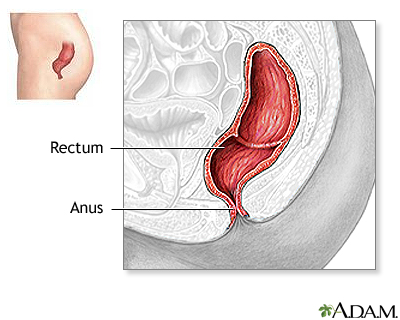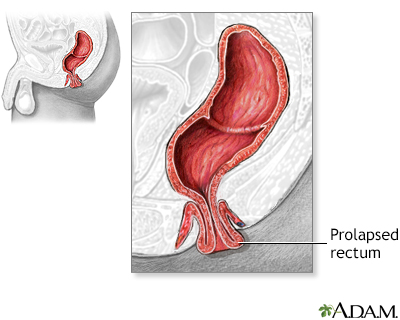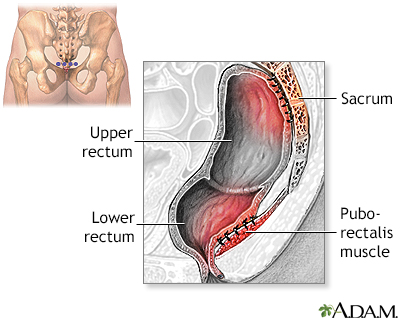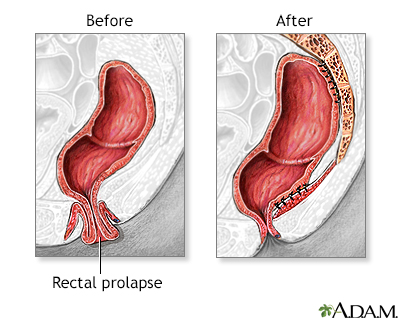Rectal prolapse repair - series

Normal anatomy
The rectum is the final portion of the large intestine. It empties stool from the body through the anus. The rectum is anchored in position by ligaments. When these ligaments weaken, the rectum can move out of its normal position, downward, and pass through the anus. This is called rectal prolapse.

Indications
Rectal prolapse may be partial, involving only the mucosa or complete, involving the entire wall of the rectum. Children with myelomeningocele and bladder exstrophy as well as children with cystic fibrosis are particularly at risk. Rarely it can be caused by acute diarrhea or straining while passing constipated stool.
Most cases of prolapse do not require surgical correction. Infant prolapse often disappears without intervention.
Rectal prolapse repair is advised for a continued rectal prolapse that does not clear up or is unresponsive to treatment of an underlying condition.

Procedure
General anesthesia is used and the patient is deep asleep and pain-free. The surgeon makes an incision near the base of the spinal column (coccyx), and identifies the pelvic floor (perineal) support structures. The lower rectum is sutured to the puborectalis muscle for support, while the upper part of the rectum is pulled up and sutured to the sacrum.

Aftercare
The surgery is usually effective in repairing the prolapse. The long-term prognosis is excellent.
Usually only 1 or 2 days of hospitalization is all that is required. Expect complete recovery within 4 weeks.
Related Information
Rectal prolapse repairRectal prolapse
BACK TO TOP
Review Date: 4/20/2022
Reviewed By: Debra G. Wechter, MD, FACS, General Surgery Practice Specializing in Breast Cancer, Virginia Mason Medical Center, Seattle, WA. Also reviewed by David C. Dugdale, MD, Medical Director, Brenda Conaway, Editorial Director, and the A.D.A.M. Editorial team.

Health Content Provider
06/01/2025
|
A.D.A.M., Inc. is accredited by URAC, for Health Content Provider (www.urac.org). URAC's accreditation program is an independent audit to verify that A.D.A.M. follows rigorous standards of quality and accountability. A.D.A.M. is among the first to achieve this important distinction for online health information and services. Learn more about A.D.A.M.'s editorial policy, editorial process and privacy policy. A.D.A.M. is also a founding member of Hi-Ethics. This site complied with the HONcode standard for trustworthy health information from 1995 to 2022, after which HON (Health On the Net, a not-for-profit organization that promoted transparent and reliable health information online) was discontinued. |
The information provided herein should not be used during any medical emergency or for the diagnosis or treatment of any medical condition. A licensed medical professional should be consulted for diagnosis and treatment of any and all medical conditions. Links to other sites are provided for information only -- they do not constitute endorsements of those other sites. © 1997- 2024 A.D.A.M., a business unit of Ebix, Inc. Any duplication or distribution of the information contained herein is strictly prohibited.
